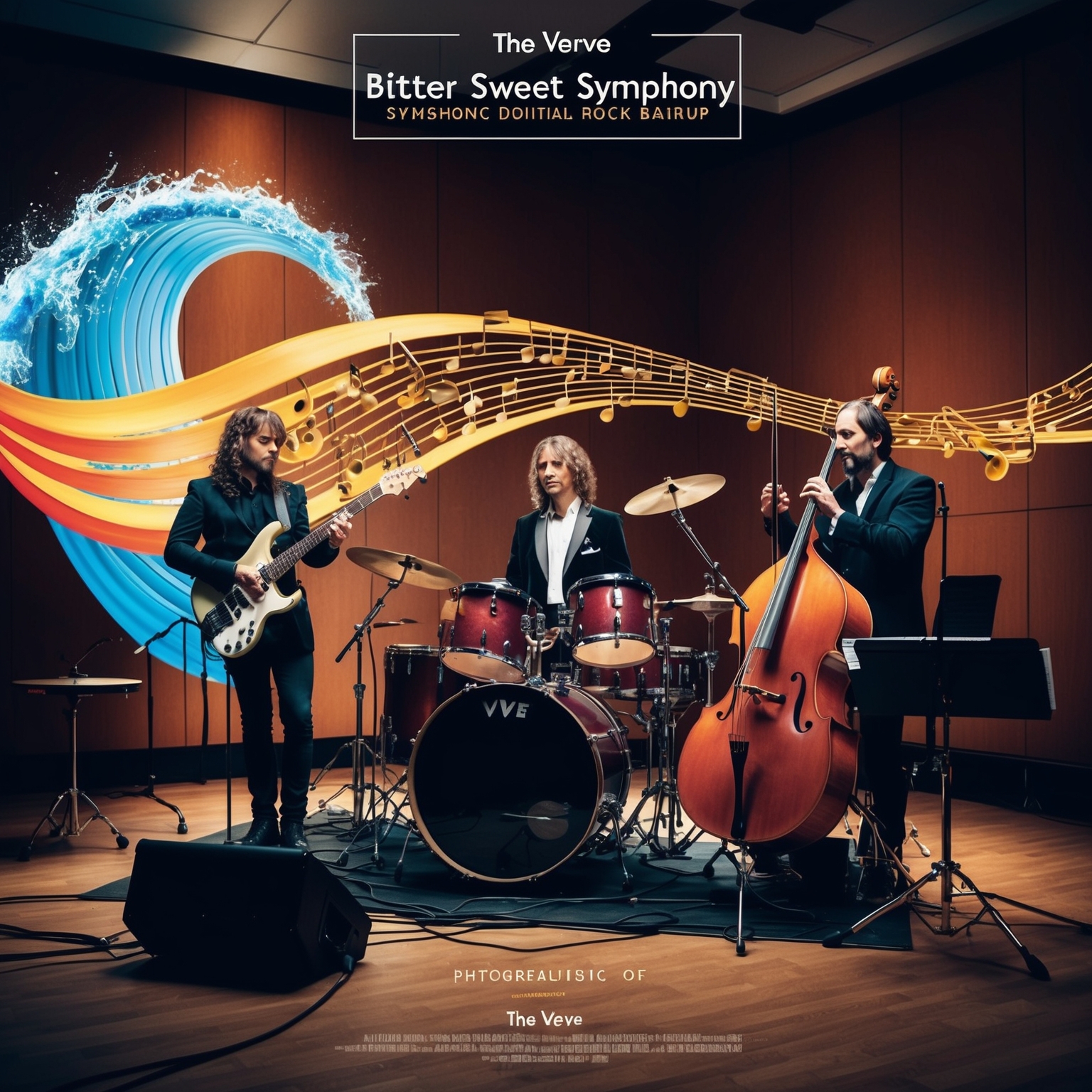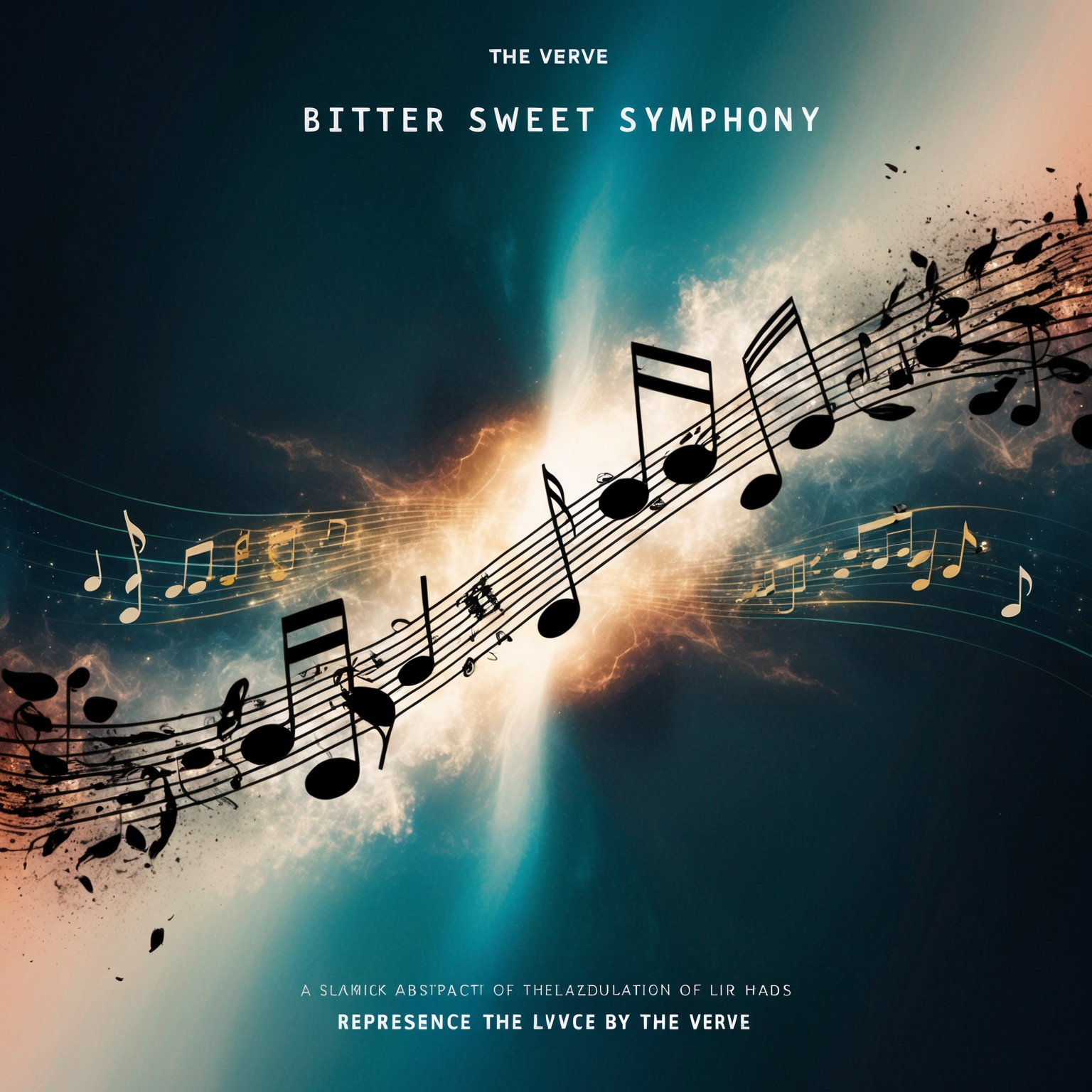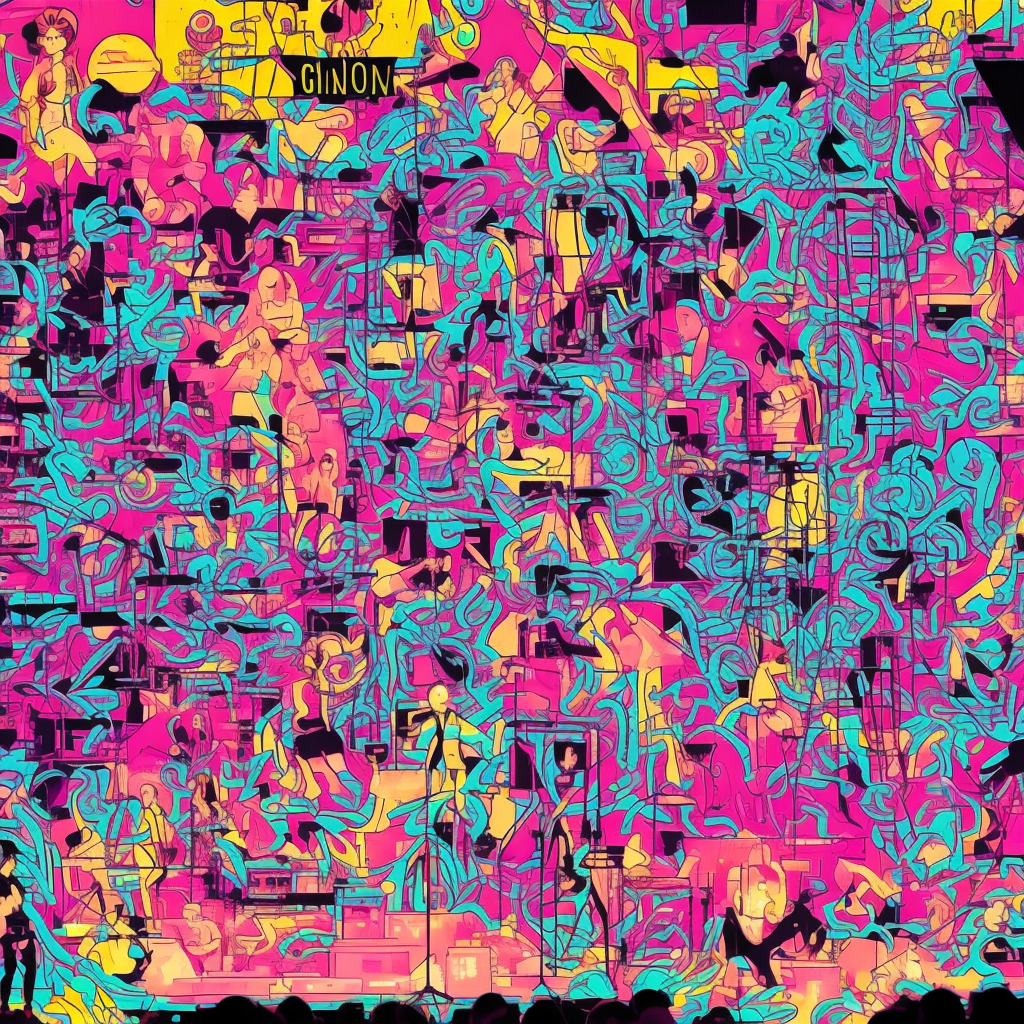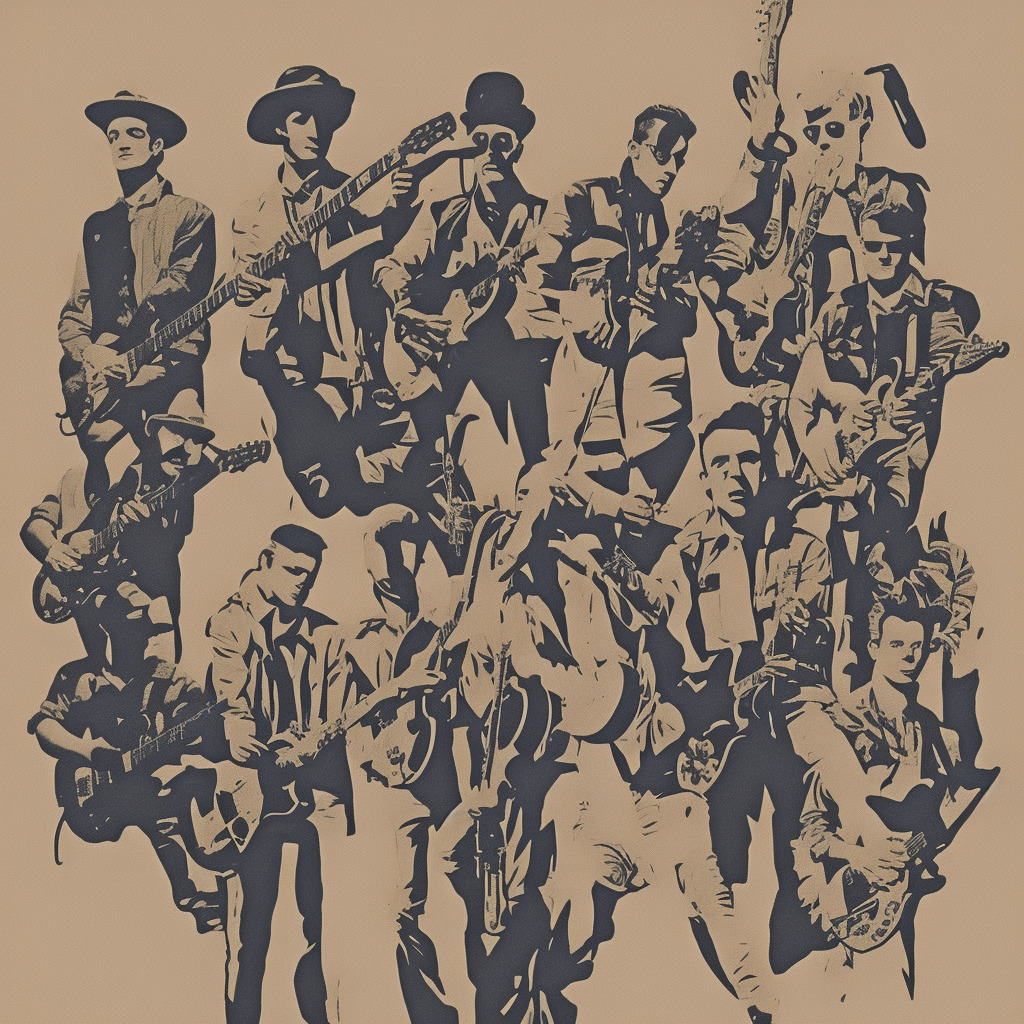The Verve: Architects of the Britpop Symphony
The Verve, with Richard Ashcroft at the helm, rose to international fame in the 90s. Known for their song “Bitter Sweet Symphony,” they became icons of the Britpop movement. This track marked a career-defining moment, showcasing their unique sound and profound lyrical depth.

The Verve, an iconic British rock band from Wigan, England, became a powerhouse in the 1990s music scene, with their unique blend of psychedelic rock and britpop. Formed in 1990, the band consisted of Richard Ashcroft, Nick McCabe, Simon Jones, and Peter Salisbury, with Simon Tong joining later. The band initially gained attention with their early releases, characterized by expansive soundscapes and a deep, emotional resonance that made them stand out in the burgeoning Britpop movement.
“Bitter Sweet Symphony,” released in 1997, was a landmark moment for The Verve, firmly placing them in the annals of music history. This single was pivotal, transforming the band from cult favorites to international superstars. It became emblematic of the 90s, capturing a cultural moment with its poignant string arrangement and introspective lyrics. For Richard Ashcroft in particular, the song was both a personal and professional triumph, showcasing his compelling songwriting and vocal prowess.
The era surrounding the release of “Bitter Sweet Symphony” was a particularly vibrant period for The Verve. Fresh from their hiatus, they had returned with a renewed sense of purpose, determined to make a lasting impact. Their creative process during the recording of the song was notable for collaborations and experimentation. Although internal tensions were a constant in the band, their collective genius shone through, setting the stage for album success and a defining role in music history.
Richard Ashcroft and the Iconic Composition of ‘Bitter Sweet Symphony’
Explore Richard Ashcroft’s instrumental role as composer of ‘Bitter Sweet Symphony,’ from his influences to the melodic mastery that defined a Britpop era.

Richard Ashcroft, the principal composer of ‘Bitter Sweet Symphony,’ stands as a towering figure in the landscape of 90s Britpop. Born in Wigan, England, Ashcroft carved his own niche in music, not only as the lead vocalist of The Verve but also as a profound songwriter whose lyrics resonate on both intellectual and emotional levels. He attended Winstanley College, where he formed The Verve with his classmates, setting the stage for a meteoric rise in the UK music scene. Known for his introspective and often brooding style, Ashcroft’s work is characterized by its raw emotion and philosophical depth.
Richard Ashcroft’s musical style is deeply rooted in the traditions of rock and Britpop, yet it extends beyond to incorporate a blend of symphonic elements and personal reflections. Influences from icons such as The Rolling Stones and The Beatles are evident in his work, alongside a penchant for transcending the ordinary through poetic lyrics. This unique fusion of rock with orchestral components reflects a cultural tapestry interwoven with historical music movements, making his compositions resonant and timeless.
Ashcroft’s collaboration with the rest of The Verve was pivotal in producing ‘Bitter Sweet Symphony,’ with its majestic strings and sweeping orchestration that grasp the listener from the first note. The infamous orchestral sample, originally from The Rolling Stones’ ‘The Last Time,’ added an innovative twist to the song, capturing an eternal balance of melancholy and hope. Richard Ashcroft’s role in crafting this masterpiece not only defined The Verve’s musical essence but also etched his name in the hall of rock history.
Honors and Tributes: The Legacy of ‘Bitter Sweet Symphony’
“Bitter Sweet Symphony” by The Verve has garnered critical acclaim with nominations for prestigious awards and has been featured in movies, TV shows, and video games. It continues to inspire artists, leading to various impactful cover versions.

Bitter Sweet Symphony by The Verve, a masterful blend of alternative rock and orchestral music, has achieved a rare and distinguished place in modern musical history. From the moment of its release, the song has captured the imagination of critics and audiences alike, earning a slew of awards, nominations, and accolades along the way. While the song itself was never officially awarded a Grammy, it has been recognized at several other prestigious music awards, including being nominated for multiple Brit Awards. Notably, its impact was profound enough to earn it a nomination for the Best British Single at the 1998 Brits, highlighting its cultural significance in its native UK.
Beyond awards, the song has been frequently referenced and included in various multimedia formats, reflecting its profound influence. ‘Bitter Sweet Symphony’ famously made a poignant appearance in the 1999 film Cruel Intentions, where it played in the film’s climactic final scene, forever linking the song with the movie’s narrative. Moreover, the song has been featured in numerous television shows and has also found its way into the gaming industry, adding emotional depth to moments across these mediums.
The song’s evocative melody and profound lyrics have led many artists to cover it, each bringing a unique take to this modern classic. Well-known covers include those by the London Grammar and the Vitamin String Quartet, who have brought their own unique styles and interpretations. The sheer number of cover versions of the song stands as a testament to its enduring legacy and ongoing influence on artists across genres.
A Resounding Triumph on the Charts
“Bitter Sweet Symphony” saw resounding success across global charts, peaking at number two in the UK and creating lasting influence beyond its time.

When The Verve’s iconic track, “Bitter Sweet Symphony,” graced listeners’ ears, it was a moment of undeniable impact. Released in June 1997, the song entered the UK Singles Chart at a respectable position but quickly ascended, peaking at number two—a position it held for several weeks. Despite never clinching the top spot, “Bitter Sweet Symphony” carved out its own niche, overshadowing many contemporaries both in sound and legacy. In the US, it reached number 12 on the Billboard Hot 100, establishing The Verve as a significant force on both sides of the Atlantic.
Compared to others in the charts, “Bitter Sweet Symphony” was a breakthrough hit that heralded a new era for the band. Before its release, The Verve had enjoyed moderate success, but this song sent their popularity soaring to new heights, allowing them to transcend the somewhat niche Britpop scene. It wasn’t merely another follow-up track; it quickly became synonymous with The Verve’s artistic identity, influencing their trajectory immensely and securing them a spot in music history.
The marketing efforts behind “Bitter Sweet Symphony” were massive but tasteful. The song’s exhaustive promotion included significant airplay across radio stations, a compelling music video, and fervent critical discussions. Its intense public reception, coupled with its blend of rock and orchestral elements, captivated both critics and fans, earning it accolades as one of the greatest rock songs of all time. Despite legal battles over the song’s sample, its cultural resonance continues to reverberate today, often featuring in film soundtracks and media.
A March Through Melancholy: The Iconic Music Video
The music video for The Verve’s “Bitter Sweet Symphony,” directed by Walter A. Stern, complements the song’s themes with its portrayal of urban isolation and defiance, contributing significantly to its success and reception.

The Verve’s music video for “Bitter Sweet Symphony” is as iconic as the song itself, encapsulating the essence of the track’s themes through its striking visuals. Directed by Walter A. Stern, this singular piece of cinematography has become emblematic in its portrayal of urban isolation and defiant perseverance. Featuring lead singer Richard Ashcroft walking down a busy London street with purpose and obliviousness to the bustling world around him, the video creates a memorable impression of the clash between individual stasis and societal chaos.
As the video progresses, Ashcroft’s character remains unwavering in his pathway, bumping into pedestrians, disregarding honking cars, and even stepping over the hood of a vehicle, all without breaking stride. This visual continuity mirrors the song’s exploration of life’s relentless, often bitter cycle within which moments of sweetness must be savored. The music video not only enhances the song’s lyrical message but also offers a visual narrative that resonates deeply with viewers.
The release of this music video significantly contributed to the song’s popularity, adding layers of interpretation and a memorable visual that accompanied radio plays and TV appearances. Critics praised the video for its artistic boldness and minimalism, which at the time stood out against the flashier music video productions of the late 1990s. While the video features no celebrity cameos, its stark execution left a lasting impact, affirming the artist’s intent and underscoring the themes of alienation and resilience.
Deconstructing the Musical Architecture of ‘Bitter Sweet Symphony’
Explore the rich musical composition of ‘Bitter Sweet Symphony’ by The Verve. Delve into its key, chord progression, tempo, and the intricate use of instruments that define its unique sound, highlighting its place within the band’s evolving discography.

‘Bitter Sweet Symphony’ is a masterclass in musical composition, crafted with precision and depth. The song is structured in the key of E major, which contributes to its uplifting yet melancholic tone. The track kicks off with an instantly recognizable orchestral sample, creating a profound emotional resonance that persists throughout the song.
Chord progression in ‘Bitter Sweet Symphony’ follows a repetitive loop, primarily using E major, A major, and B7 chords. This simplicity in chord structure allows the listener to be enveloped more profoundly by the layers of sound. The tempo of the song is set at a moderate 85 beats per minute, offering a reflective and contemplative pace that complements its lyrical themes.
Analyzing the melody, the song showcases a rich interplay of harmony and rhythm, where the string section serves as a melodic anchor. The Verve’s innovative use of instrumentation includes strings, guitar, bass, and drums, contributing to the song’s lush, symphonic soundscape. The strings provide both tension and release, echoing the lyrical exploration of life’s bittersweet nature. The combination of Richard Ashcroft’s soulful vocals and the orchestral arrangement creates a dynamic harmony that is both enthralling and emotionally stirring.
In the context of The Verve’s discography, ‘Bitter Sweet Symphony’ marks a significant evolution in the band’s sound. While their earlier work was more rooted in Britpop and alternative rock, this track highlighted their shift towards orchestral and experimental rock. The sophistication in its musical structure and thematic depth distinguished the song, cementing it as an iconic piece in their artistic journey.
Interesting anecdotes from the recording sessions illuminate the song’s production. Recorded at Olympic Studios in London and produced by Martin ‘Youth’ Glover, the song’s ambitious sound was a critical factor in both its production challenges and its success. The orchestral sample used in the track famously led to legal disputes, adding a layer of intrigue and history to the song’s evolution.
Peeling Back the Layers of ‘Bitter Sweet Symphony’ by The Verve
Delve into the profound lyrics of ‘Bitter Sweet Symphony’ by The Verve in this in-depth analysis. Explore its themes of existential struggle, societal critique, and personal introspection, enriched by literary devices and fan interpretations that enhance its timeless appeal.
Tryin’ to make ends meet, you’re a slave to money then you die
I’ll take you down the only road I’ve ever been down
You know the one that takes you to the places where all the veins meet, yeah
No change, I can change, I can change, I can change
But I’m here in my mold, I am here in my mold
But I’m a million different people from one day to the next
I can’t change my mould, no, no, no, no, no
(Have you ever been down?)
Well, I’ve never prayed, but tonight I’m on my knees, yeah
I need to hear some sounds that recognize the pain in me, yeah
I let the melody shine, let it cleanse my mind, I feel free now
But the airwaves are clean and there’s nobody singing to me now
…
******* This Lyrics is NOT for Commercial use *******
 Lyrical Themes and Messages: At its core, ‘Bitter Sweet Symphony’ by The Verve delivers a somber yet profound reflection on the human condition. The song’s lyrics merge the relative sweetness of life with its bitterness, encapsulated in the iconic line, ‘Cause it’s a bitter sweet symphony, that’s life.’ Here, the lyrics echo themes that are existential and almost philosophical, suggesting that life is a complex interplay of joy and struggle. By likening life to a symphony, Richard Ashcroft, the band’s lead vocalist and songwriter, invokes a sense of orchestrated beauty against the inevitable backdrop of struggle and desire. The imagery of slavery to money further cements the societal critique embedded within the lyrics, resonating with audiences grappling with similar concerns.
Lyrical Themes and Messages: At its core, ‘Bitter Sweet Symphony’ by The Verve delivers a somber yet profound reflection on the human condition. The song’s lyrics merge the relative sweetness of life with its bitterness, encapsulated in the iconic line, ‘Cause it’s a bitter sweet symphony, that’s life.’ Here, the lyrics echo themes that are existential and almost philosophical, suggesting that life is a complex interplay of joy and struggle. By likening life to a symphony, Richard Ashcroft, the band’s lead vocalist and songwriter, invokes a sense of orchestrated beauty against the inevitable backdrop of struggle and desire. The imagery of slavery to money further cements the societal critique embedded within the lyrics, resonating with audiences grappling with similar concerns.
Narrative and Storytelling: The lyrics adopt a semi-linear narrative, delivered in the first person, allowing listeners to experience the introspection and disillusionment firsthand. ‘Tryin’ to make ends meet, you’re a slave to money then you die’ introduces a sense of futility and constraint that pervades the human experience. Ashcroft’s storytelling is introspective, inviting listeners to journey with him down the ‘only road I’ve ever been down,’ a symbolic path of human endeavor and self-discovery. This narrative choice amplifies the song’s emotional impact, as it invites introspection and self-identification.
Use of Literary Devices: The lyrics of ‘Bitter Sweet Symphony’ are rich in literary devices. Metaphors proliferate throughout, with the depiction of life as a symphony being a salient example. The subtle yet persistent use of repetition, such as ‘I can’t change my mould, no, no, no, no, no,’ emphasizes human resistance to change and the static nature of one’s essence. This repetition not only reinforces the lyrical theme but also contributes to the song’s hypnotic quality. Simultaneously, vivid imagery evokes raw emotionality, particularly in lines like ‘I need to hear some sounds that recognize the pain in me, yeah,’ which convey a deep yearning for empathy and connection. The blend of these devices creates a profound tapestry that resonates with lyrical meaning.
Comparative Analysis with Other Works: When compared to other songs by The Verve, such as ‘The Drugs Don’t Work,’ ‘Bitter Sweet Symphony’ stands out with its grand, metaphorical encapsulation of life’s dualities. While ‘The Drugs Don’t Work’ delves into personal heartbreak and resignation, ‘Bitter Sweet Symphony’ adopts a broader societal commentary. Both songs share a thematic undercurrent of despair but are distinguished by the former’s intimate focus and the latter’s more universal scope, showcasing The Verve’s lyrical versatility.
Cultural and Social References: ‘Bitter Sweet Symphony’ resonates with its time of release in 1997, a period marked by economic fluctuations and the rise of consumer culture. The pervasive mention of being a ‘slave to money’ reflects a critique of materialism and societal priorities, a sentiment that remains relevant. These cultural references add depth to the song, engaging listeners across generations with its timeless observation and critique.
Emotional Impact and Relatability: The song’s emotive force lies in its relatability, drawing listeners with its honest portrayal of life’s struggles. Feelings of hope, loss, and existential pondering are intertwined, inviting listeners to reflect on their own lives and societal constraints. Such emotional resonance has likely contributed to the song’s enduring popularity, allowing it to transcend time and garner new audiences.
Language and Wordplay: Ashcroft’s language choice leans towards simplicity, which enhances the lyrics’ accessibility and emotional clarity. Despite this simplicity, the wordplay within ‘Bitter Sweet Symphony’ remains impactful. Phrases such as ‘I am here in my mold’ suggest both physical and metaphorical constraints, a clever play that enriches the lyrical dimension.
Controversies or Misinterpretations: One of the most salient controversies surrounding ‘Bitter Sweet Symphony’ is not entirely about its lyrics but rather the song’s rights and composition. The legal battle with The Rolling Stones overshadowed some aspects of the lyrical interpretation, intriguing audiences further but also sparking discussions about ownership and creativity. Nonetheless, the song’s lyrical message has remained largely uncontested in its interpretation as a poignant reflection on life.
Fan Theories and Interpretations: Various fan interpretations suggest that ‘Bitter Sweet Symphony’ discusses more than just financial constraints—it reflects a deeper philosophical discourse on identity, fate, and self-realization. Fans often interpret the repeated insistence on unchanging personal molds as a meditation on the struggle between personal authenticity and societal expectation. These theories highlight the song’s layered meanings and its invitation to individual reflection.
Personal Reflections of the Artist: Richard Ashcroft has often spoken about the personal nature of ‘Bitter Sweet Symphony,’ mentioning its ties to his own life experiences and philosophical musings. His reflections provide a window into the song’s personal and universal relevance, deepening its impact and lending credibility to the raw honesty that the lyrics reflect. This layer of personal introspection coupled with societal observation cements ‘Bitter Sweet Symphony’ as a timeless piece.
? Did you know? Bitter Sweet Symphony almost didn’t happen! The iconic string riff is a sample from The Rolling Stones! ?✨ #TheVerve #MusicTrivia #BritpopClassic tinyurl.com/2afhmu6z
Click to Tweet







